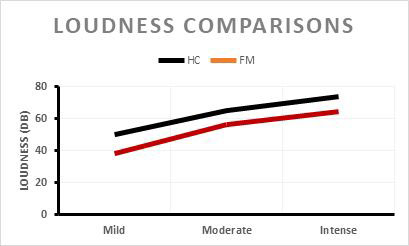Session Information
Session Type: Poster Session (Sunday)
Session Time: 9:00AM-11:00AM
Background/Purpose: Fibromyalgia (FM) is a condition in which patients are afflicted with unexplained chronic musculoskeletal pain, insomnia and fatigue. The underlying mechanisms of this disorder is only partially understood. FM patients frequently report not only hypersensitivities to noxious but also to non-noxious sensations like light touch, sounds, and smells encountered in everyday life. Despite anecdotal reports of unusual sensory sensitivities of FM patients, there has been little or no empirical validation of these complaints in current research. The presence of such sensitivities may contribute to difficulties in function by creating an additional source of stress, anxiety, and fatigue
Hypothesis: Compared to age-sex matched healthy controls (HC), FM patients are not only hypersensitive to A) noxious heat and pressure but also to B) auditory stimuli across 3 different sound intensity levels
Methods: FM subjects fulfilled the 1990 FM Criteria and were not taking pain or psychotropic medications. HC had to be without pain and without any medications. All subjects underwent heat and pressure sensory testing at the hand using sensitivity adjusted stimuli that elicited pain rating of 5 ± 1 VAS (0-10). The subjects underwent auditory threshold testing to ensure normal hearing at frequencies between 1,000 and 4,000 Hz using a GSI 61 Clinical Audiometer. Subsequently, they received auditory stimuli of mixed frequencies at intensities that resulted in mild (12.5 dB, moderate 32.5 dB, and intense (67.5 dB) loudness. All tests were performed in triplicates.
Results: We enrolled 26 HC and 20 FM subjects (all females). Their ages were 52.3 years and 47.5 years, respectively. Avg pain of FM subjects was 4.6 VAS (0-10). Independent t-test demonstrated significantly lower temperature and pressure to achieve 5 VAS for FM subjects than HC (all p < .001). A mixed model ANOVA showed that FM subject required significantly less sound intensity (dB) to rate similar loudness compared to HC (p < .001). Pearson’s product moment correlations demonstrated significant associations between auditory and heat/pressure sensitivity (p < .05)
Conclusion: Patients with FM are more sensitive to sensory stimuli in daily life than patients who do not experience chronic pain. Their hypersensitivity, however, seems to extend beyond heat and pressure to auditory and possibly to taste/smell and visual sensations. Our findings suggest that FM patients not only demonstrate hypersensitivity to painful but also auditory stimuli. Furthermore, auditory hypersensitivity predicted heat/pressure pain hypersensitivity. Besides genetic predisposition other factor could explain our findings, specifically the “Cognitive Activation Theory of Stress (CATS)”, a theoretical model tying together chronic pain and hyperacusis. CATS postulates that sustained arousal and lack of appropriate arousal resolution (i.e., restful sleep) can result in dysfunction of the central nervous system. In particular, chronic arousal and lack of restorative sleep, can lead to increased sensitivity to peripheral neural input, resulting in chronic pain and hyperacusis
To cite this abstract in AMA style:
Staud R, Tom G, Godfrey M, Robinson M. Hypersensitivity Beyond Pain: Hyperacusis and Hyperalgesia of Patients with Fibromyalgia [abstract]. Arthritis Rheumatol. 2019; 71 (suppl 10). https://acrabstracts.org/abstract/hypersensitivity-beyond-pain-hyperacusis-and-hyperalgesia-of-patients-with-fibromyalgia/. Accessed .« Back to 2019 ACR/ARP Annual Meeting
ACR Meeting Abstracts - https://acrabstracts.org/abstract/hypersensitivity-beyond-pain-hyperacusis-and-hyperalgesia-of-patients-with-fibromyalgia/

